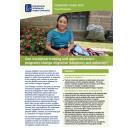Systematic review
Quality education for all children?
Governments and donors as part of their commitment to achieve Education for All by 2015 have pledged to get children into school, provide them with quality education and respond to their learning needs. But what is most effective in getting children into school, keeping them there and ensuring that they learn?
The brief, Quality education for all children? on a 3ie working paper by Krishnaratne, S., White, H. Carpenter, E. It distills policy relevant messages on the impact of education interventions that address both demand and supply side challenges.
Key messages
- Development interventions are not only getting more children into school and keeping them are also helping children to learn more.
- But some interventions work better than others and different interventions work for different outcomes
- Conditional cash transfers increase school and attendance, but have no overall impact on children’s test scores.
- School improve and progress in school, while merit-based scholarships increase learning.
- Distributing teaching and learning aids in school has no impact on school attendance and language test scores of children. However, computer-based learning offered in addition to the regular school curriculum has positive impacts on mathematics test scores.
- Doing a cost-benefit allow policymakers to compare more easily, and also make informed choices about which interventions to launch.




